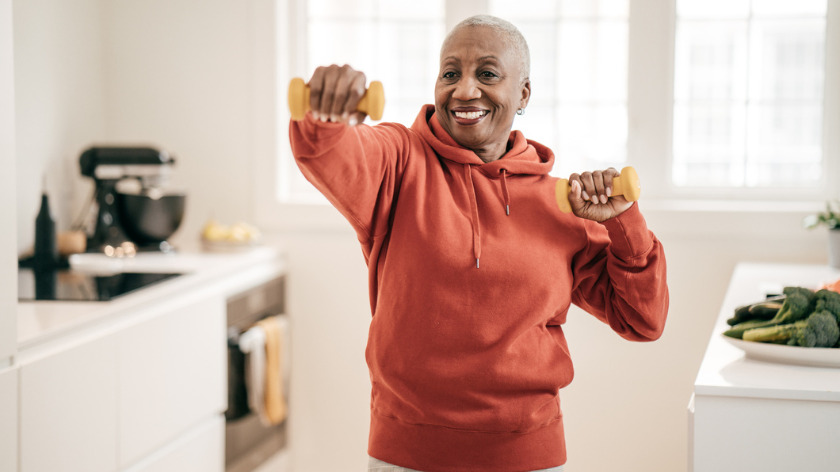National Exercise Day is celebrated on April 18 to encourage participation in physical activity and exercise. The main message is to get out there and get moving to experience all the positive benefits of exercise – not only on this day but throughout the year.
Being physically active is one of the most important things you can do for your health. Moving your body has a number of benefits, from helping to manage weight and reducing the risk of disease, to improving brain health, strengthening bones and muscles, and helping you complete everyday activities.
Ready to get started? The FITT principle provides a framework to set you up with a solid plan.
F = Frequency: how often you will work out
I = Intensity: how hard you will push yourself
T = Time: for how long you will exercise
T = Type: the kind of exercise
The FITT principles apply to everyone, from the beginner to the elite athlete. Use these principles to establish a routine based on what will work best for you and the goals that you are looking to achieve.
Frequency
According to the Centers for Disease Control and Prevention, the recommendation for adults is 150 minutes of moderate-intensity physical activity and 2 days of muscle-strengthening activity.
Intensity
To measure if you are exercising at a moderate or vigorous intensity, you can use a perceived level of exertion (subjective measure) or heart rate (objective measure).
- Perceived Exertion: Are you breathing hard, but can still talk and carry on a conversation while engaging in physical activity? If so, you most likely are exercising at a moderate intensity. If you cannot say more than a few words without having to catch your breath – then you are exercising at a vigorous intensity. You can also use the Borg Rating of Perceived Exertion (RPE). On a scale of 6 – 20, a rating of 6 is perceived as “no exertion at all” and 20 is perceived as a “maximal exertion” of effort. Physical activity at a moderate level of intensity generally falls between 12 to 14 on the Borg Scale.
- Heart Rate: These days, there are a wide variety of fitness devices that can track your heart rate. Synching your device to the Vitality program is a great way to earn daily points for your workouts. You can also estimate your maximum heart rate based on your age. Subtract your age from 220 to find your maximum age-related heart rate. Then, to calculate moderate intensity, take 64% – 76% of that maximum heart rate. To calculate vigorous intensity, take 77% – 93% of your maximum heart rate.
- Example: If you are 50 years old, your max heart rate is: 220 – 50 = 170 beats per minute (bpm). Your moderate intensity range would be 64% – 76% of max heart rate (170) = 109 bpm – 129 bpm. Your vigorous intensity range would be 77% – 93% of max heart rate (170) = 131 bpm – 158 bpm.
Time
Aim for the minimum recommendation of 150 minutes per week. That comes out to only thirty minutes, five days a week. Based on your schedule, you can also break that down into smaller sessions and spread it out more throughout the week.
Type
- Aerobic exercise is also referred to as endurance or cardio activities. This type of exercise uses oxygen as its main fuel source. Your heart rate increases, and you are moving your body for a sustained period of time. This type of activity strengthens your heart and lungs. Aerobic activities include walking, running, jumping rope, hiking, biking, playing sports and dancing.
- Strength/resistance training is an effective way to build strength. Strength training can help improve overall physical health by increasing the strength of your muscles, ligaments and tendons, increasing bone density, and potentially reducing the risk of osteoporosis. It also revs up your metabolism to help you burn more calories, which can lead to a possible reduction in body fat and an increase in lean muscle mass. Strength training can also improve your sense of coordination and balance, improve your posture and reduce your risk of injury. Strength training activities include lifting weights with dumbbells, barbells, kettlebells, or traditional gym machines. You can also use resistance bands, sandbags, or simply your own body weight (squats or push-ups) as external resistance.
- Flexibility/mobility is being able to move your body and joints through a full range of motion. A regular flexibility routine may potentially decrease your risk of injury, ease muscle soreness and stiffness, improve posture and balance, and in general, help you move more efficiently. Incorporate flexibility into your routine by stretching, taking a yoga or Pilates class, practicing tai chi or using a foam roller.
The best way to stay consistent with an exercise program is to make it fun so that you look forward to each workout session. Keep it varied, find a community of like-minded people to work out with, choose a goal to work towards, track your progress and reward your successes along the way!
Looking for some additional inspiration? Check out our Vitality Moves series and read these blogs for additional information on exercise:
- Options to Optimize Your Workouts
- Getting the Most Health Benefits from Our Workouts – Whatever Our Age
- Progress Not Perfection: Overcoming a Lack of Motivation to Exercise
- The Benefits of Strength Training

Janine is an Implementation Manager with Vitality. She holds a B.S. in Exercise Science/Sport Management from Rutgers University, as well as many certifications within the fitness and nutrition industry. She loves being a spectator/photographer at her daughters’ athletic events, writing on sticky notes, over-consuming nut butters, shiny lip gloss, taking hot yoga classes and competing in triathlons. For relaxation, she enjoys baking, taking naps in hammocks, and listening to podcasts.





